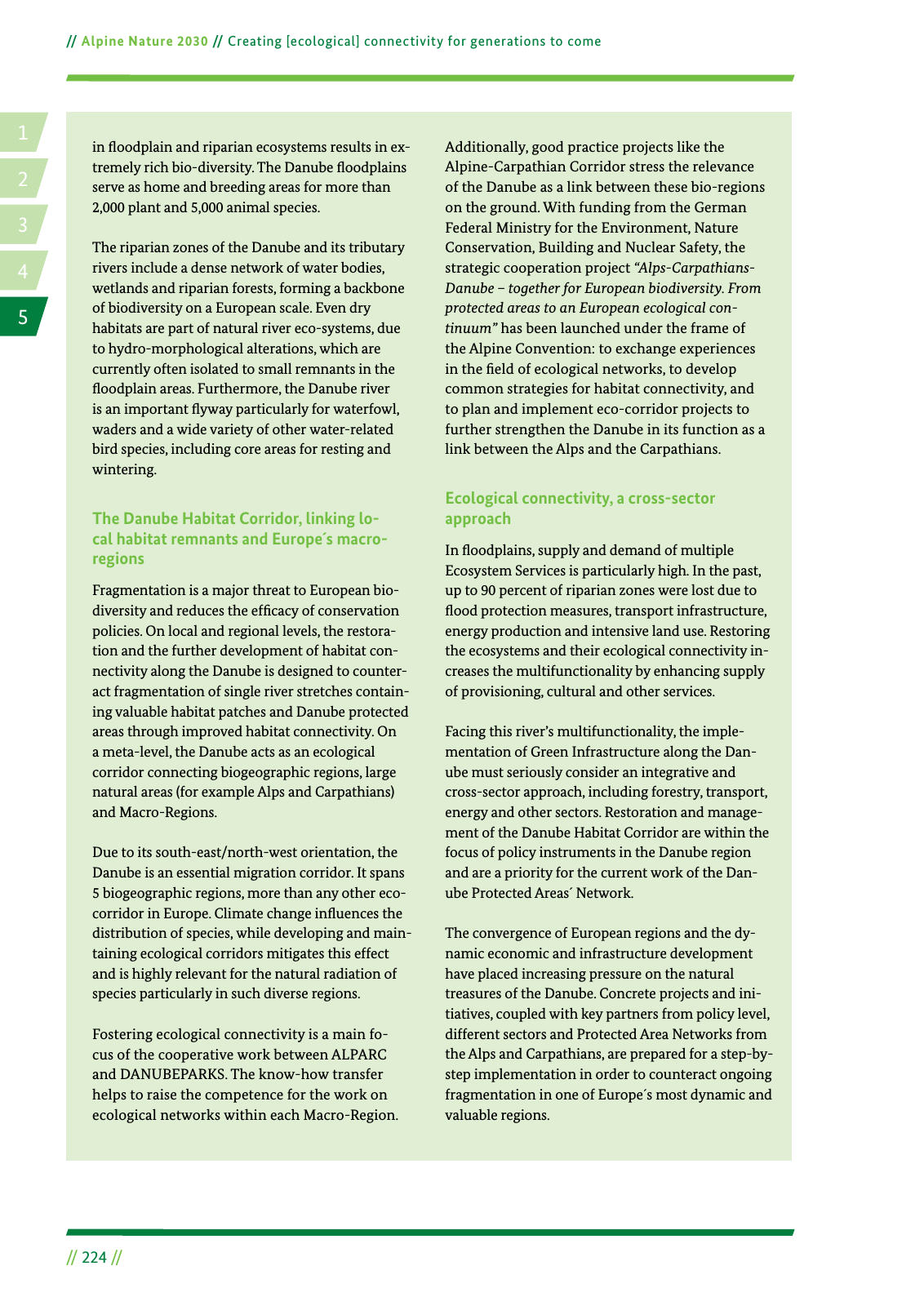14 2 5 3 Alpine Nature 2030 Creating ecological connectivity for generations to come 224 in oodplain and riparian ecosystems results in ex tremely rich bio diversity The Danube oodplains serve as home and breeding areas for more than 2 000 plant and 5 000 animal species The riparian zones of the Danube and its tributary rivers include a dense network of water bodies wetlands and riparian forests forming a backbone of biodiversity on a European scale Even dry habitats are part of natural river eco systems due to hydro morphological alterations which are currently often isolated to small remnants in the oodplain areas Furthermore the Danube river is an important yway particularly for waterfowl waders and a wide variety of other water related bird species including core areas for resting and wintering The Danube Habitat Corridor linking lo cal habitat remnants and Europe s macro regions Fragmentation is a major threat to European bio diversity and reduces the ef cacy of conservation policies On local and regional levels the restora tion and the further development of habitat con nectivity along the Danube is designed to counter act fragmentation of single river stretches contain ing valuable habitat patches and Danube protected areas through improved habitat connectivity On a meta level the Danube acts as an ecological corridor connecting biogeographic regions large natural areas for example Alps and Carpathians and Macro Regions Due to its south east north west orientation the Danube is an essential migration corridor It spans 5 biogeographic regions more than any other eco corridor in Europe Climate change in uences the distribution of species while developing and main taining ecological corridors mitigates this effect and is highly relevant for the natural radiation of species particularly in such diverse regions Fostering ecological connectivity is a main fo cus of the cooperative work between ALPARC and DANUBEPARKS The know how transfer helps to raise the competence for the work on ecological networks within each Macro Region Additionally good practice projects like the Alpine Carpathian Corridor stress the relevance of the Danube as a link between these bio regions on the ground With funding from the German Federal Ministry for the Environment Nature Conservation Building and Nuclear Safety the strategic cooperation project Alps Carpathians Danube together for European biodiversity From protected areas to an European ecological con tinuum has been launched under the frame of the Alpine Convention to exchange experiences in the eld of ecological networks to develop common strategies for habitat connectivity and to plan and implement eco corridor projects to further strengthen the Danube in its function as a link between the Alps and the Carpathians Ecological connectivity a cross sector approach In oodplains supply and demand of multiple Ecosystem Services is particularly high In the past up to 90 percent of riparian zones were lost due to ood protection measures transport infrastructure energy production and intensive land use Restoring the ecosystems and their ecological connectivity in creases the multifunctionality by enhancing supply of provisioning cultural and other services Facing this river s multifunctionality the imple mentation of Green Infrastructure along the Dan ube must seriously consider an integrative and cross sector approach including forestry transport energy and other sectors Restoration and manage ment of the Danube Habitat Corridor are within the focus of policy instruments in the Danube region and are a priority for the current work of the Dan ube Protected Areas Network The convergence of European regions and the dy namic economic and infrastructure development have placed increasing pressure on the natural treasures of the Danube Concrete projects and ini tiatives coupled with key partners from policy level different sectors and Protected Area Networks from the Alps and Carpathians are prepared for a step by step implementation in order to counteract ongoing fragmentation in one of Europe s most dynamic and valuable regions

Hinweis: Dies ist eine maschinenlesbare No-Flash Ansicht.
Klicken Sie hier um zur Online-Version zu gelangen.
Klicken Sie hier um zur Online-Version zu gelangen.